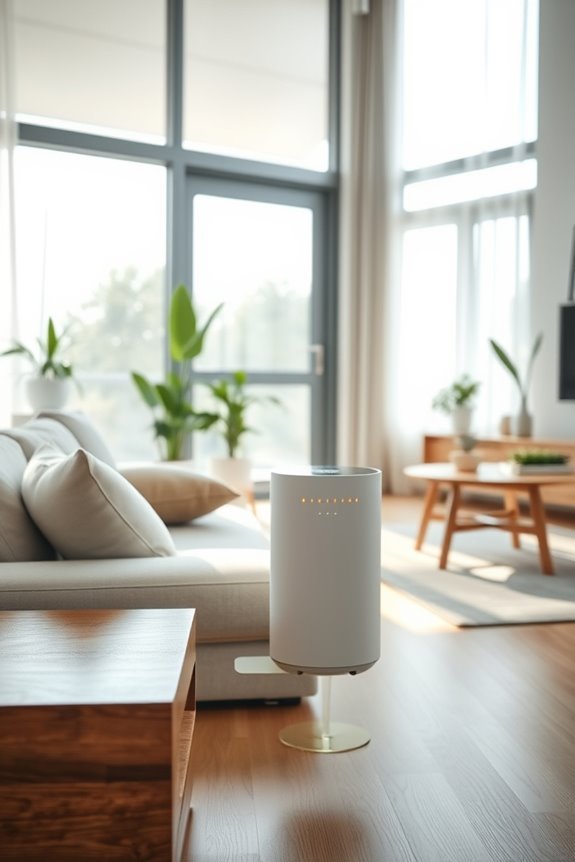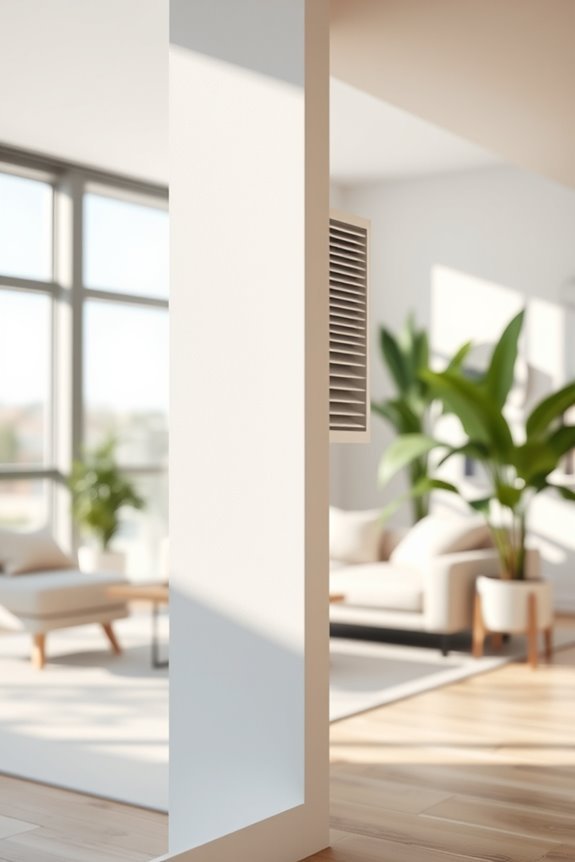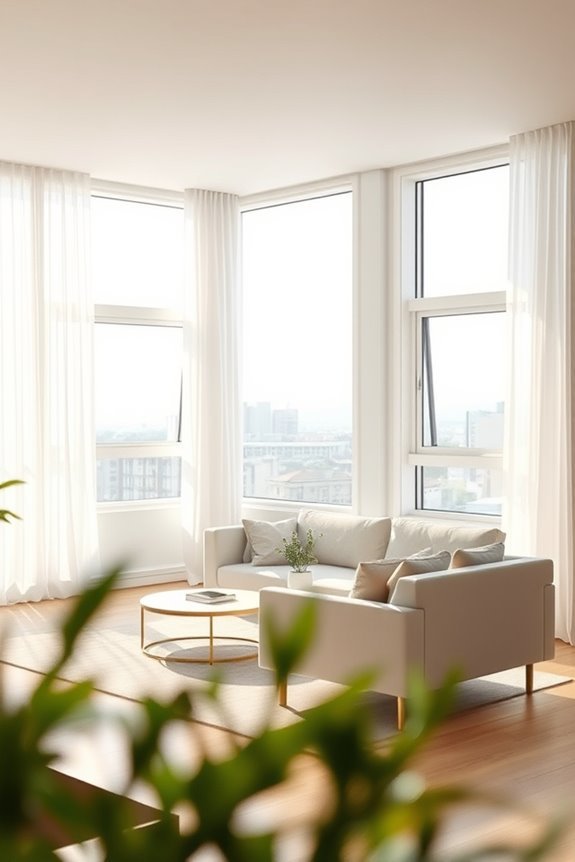How to Create Positive Air Pressure in an Apartment?
To create positive air pressure in your apartment, start by sealing gaps around windows and doors to prevent drafts. Use exhaust fans effectively to remove stale air while ensuring fresh air comes in. Regularly assess airflow with tools like an anemometer, and manage humidity levels with dehumidifiers. Additionally, choose air-purifying plants to enhance air quality. By implementing these strategies, you’ll enjoy a healthier living space. There’s more to explore to optimize your home’s air dynamics.
Understanding Positive Air Pressure

Understanding positive air pressure is essential for maintaining a comfortable living environment in your apartment. Positive air pressure helps keep unwanted pollutants and allergens out, leading to better indoor air dynamics.
Grasping positive air pressure is key to ensuring a healthy, comfortable apartment by keeping pollutants and allergens at bay.
When you grasp these air pressure concepts, you can take steps to guarantee that your living space remains fresh and inviting. To achieve this, you can use exhaust fans and strategically placed air vents to create a balance in airflow.
By bringing in outside air while minimizing drafts, you’re promoting a healthier atmosphere. Regularly checking for leaks and sealing gaps also aids in maintaining that positive pressure.
Ultimately, applying these principles not only enhances your comfort but also contributes to a more enjoyable living space.
Importance of Indoor Air Quality
Indoor air quality is vital for your health and well-being, especially in an apartment where space is limited and air circulation can be restricted.
Poor indoor air quality can lead to a buildup of indoor pollutants like dust, mold, and volatile organic compounds. These pollutants can cause respiratory issues, allergies, and other health problems.
By maintaining good air quality, you not only meet air quality standards but also create a healthier living environment. It’s important to regularly ventilate your apartment and use air purifiers to filter out harmful particles.
Taking these steps guarantees that you breathe cleaner air, enhancing your overall comfort and health in your living space.
Prioritizing indoor air quality is a key element in creating a safe home.
Assessing Your Current Airflow
To create a healthier living environment, you need to evaluate the airflow in your apartment. Start with an airflow assessment to identify how air moves throughout your space. You can use simple tools like an anemometer for airflow measurement, or even just your senses. Check for areas that feel stuffy or drafty, as these can indicate problems.
Here’s a quick table to help you understand the assessment process:
| Step | Action |
|---|---|
| Identify Sources | Look for windows, vents |
| Measure Airflow | Use tools or observe |
| Analyze Results | Note areas needing attention |
Once you’ve assessed your airflow, you’ll be better equipped to create positive air pressure in your apartment.
Sealing Gaps and Cracks
As you work to create positive air pressure in your apartment, sealing gaps and cracks is essential for preventing unwanted air leaks.
Start by inspecting areas around windows, doors, and vents where drafts might sneak in. Use quality drafting materials like caulk or weatherstripping to fill these gaps effectively.
Inspect windows, doors, and vents for drafts, and use caulk or weatherstripping to seal gaps effectively.
Apply sealing techniques by carefully caulking around window frames and door edges, ensuring a snug fit. Pay attention to electrical outlets and plumbing penetrations, as they can also be sources of air leaks.
After sealing, check your work to make sure everything is airtight. By addressing these gaps and cracks, you’ll enhance your apartment’s air pressure, making your living space more comfortable and energy-efficient.
Utilizing Exhaust Fans
After sealing gaps and cracks, utilizing exhaust fans effectively helps maintain positive air pressure in your apartment.
You’ll want to choose the right exhaust fan types to match your needs, such as bathroom, kitchen, or whole-house fans. Each type serves a specific purpose, so consider where you need ventilation most.
Proper fan installation is vital; make certain it’s mounted correctly to maximize efficiency. When you run these fans, they remove stale air, which helps create a vacuum effect that encourages fresh air to enter your space from outside.
Timing is also essential—use them during peak hours or when cooking to optimize air pressure.
Installing Positive Pressure Ventilation Systems

Installing a positive pressure ventilation system can greatly improve your apartment’s air quality, especially when you need a consistent supply of fresh air.
These systems work by pushing filtered air into your living space, creating positive pressure that helps prevent outdoor pollutants from entering.
Positive pressure ventilation systems push filtered air indoors, effectively blocking outdoor pollutants from entering your living space.
There are various ventilation types to evaluate, such as centralized systems, which distribute air throughout your apartment, and localized systems, which target specific areas.
Before installation, assess your apartment’s layout and choose a system that fits your needs.
Verify you have the right size and type of fans to maintain ideal airflow.
Once installed, regularly check filters to keep your air clean and enjoy a healthier indoor environment.
Benefits of Air Purifiers
While you mightn’t realize it, the air quality in your apartment can greatly impact your health and well-being. Air purifiers are an effective way to enhance that quality by removing allergens, dust, and pollutants from the air.
When you breathe cleaner air, you may notice fewer allergy symptoms and improved respiratory health. Additionally, air purifiers can eliminate harmful bacteria and viruses, providing further health benefits for you and your loved ones.
By investing in an air purifier, you create a more comfortable living space that promotes better sleep and overall mood.
Regular Maintenance of HVAC Systems
Keeping your HVAC system in top shape is essential for maintaining positive air pressure in your apartment.
Regularly replacing filters and cleaning ducts can greatly improve air quality and system efficiency.
Filter Replacement Schedule
A regular filter replacement schedule is essential for maintaining your HVAC system’s efficiency and ensuring positive air pressure in your apartment.
Different filter types, such as HEPA, fiberglass, and pleated filters, have varying replacement intervals. Generally, you should replace fiberglass filters every 1-3 months, pleated filters every 3-6 months, and HEPA filters about once a year.
However, if you have pets or allergies, you may need to change them more frequently. Keep an eye on your filters and check them monthly for dirt and debris buildup.
Duct Cleaning Importance
Regular duct cleaning is essential for maintaining the efficiency of your HVAC system and ensuring clean air circulation throughout your apartment.
When you prioritize duct maintenance, you reap several benefits that enhance your living environment:
- Improved air quality, reducing allergens and dust
- Enhanced energy efficiency, lowering your utility bills
- Prolonged lifespan of your HVAC system, saving on replacement costs
- Reduction of unpleasant odors circulating in your home
- Better airflow, creating a more comfortable living space
Strategic Window Placement

To create positive air pressure in your apartment, the placement and orientation of your windows are vital.
You’ll want to reflect on how to utilize cross ventilation effectively and seal any gaps that might disrupt airflow.
Let’s explore how these strategies can enhance your living space’s air quality.
Optimal Window Orientation
When you strategically place windows in your apartment, you can greatly enhance positive air pressure and improve ventilation.
Consider the following factors for ideal window orientation:
- Solar Orientation: Position windows to capture sunlight, especially in colder months.
- Window Types: Use casement or awning windows that can open wider for increased airflow.
- Height and Size: Install larger windows higher up to allow warm air to escape while drawing in cooler air.
- Shading: Incorporate overhangs or shades to reduce heat in summer while maximizing light in winter.
- Cross-Flow: Though not discussing it here, think about how window placement can facilitate future cross-ventilation efforts.
With these considerations, you’ll create a more comfortable living space with better air quality.
Utilize Cross Ventilation
While many overlook the importance of window placement, utilizing cross ventilation can greatly enhance air pressure and comfort in your apartment.
By strategically arranging your windows, you can create a flow of fresh air that promotes positive air pressure. Start by opening windows on opposite sides of your apartment to allow for a direct pathway of airflow.
If you have a balcony, take advantage of its airflow by opening the balcony door, which can help draw air through the living space.
Make sure your window arrangement maximizes this effect, as even slight adjustments can considerably improve ventilation.
With effective cross ventilation, you’ll enjoy a fresher environment and better indoor air quality without relying solely on fans or air conditioning.
Sealing Gaps Effectively
Sealing gaps around your windows is essential for maintaining positive air pressure in your apartment. Effective gap sealing techniques can help you avoid drafts and keep your indoor air comfortable.
Start by identifying any leaks using draft detection methods like:
- Candle Test: Light a candle and move it around window edges; flickering indicates drafts.
- Smoke Test: Use incense to spot air movement near gaps.
- Visual Inspection: Look for visible cracks or spaces around frames.
For sealing the gaps, consider using:
- Foam Sealant: Apply expanding foam in larger gaps for a tight seal.
- Weatherstripping: Add adhesive strips to window sashes to eliminate air leaks.
Using Fans Effectively
Using fans effectively can greatly enhance positive air pressure in your apartment. Start by choosing the right fan types—such as box fans, ceiling fans, or oscillating fans.
Next, focus on fan placement. Position fans near windows or doors to push air into your living space. Here’s a quick guide:
| Fan Type | Ideal Placement | Effectiveness |
|---|---|---|
| Box Fan | Window facing inward | Draws in fresh air |
| Ceiling Fan | Center of the room | Circulates air |
| Oscillating Fan | Near airflow entrance | Distributes air evenly |
Incorporating Fresh Air Intakes
To boost positive air pressure in your apartment, incorporating fresh air intakes is a smart strategy.
These intakes allow you to bring in fresh air sources, creating a healthier environment. Here’s how to implement them effectively:
- Install intake filters to purify the incoming air.
- Position vents strategically to maximize airflow throughout your space.
- Use energy-efficient systems to maintain low energy costs while guaranteeing adequate ventilation.
- Seal any gaps around windows and doors to prevent unintentional air leaks.
- Monitor air quality regularly to confirm your fresh air sources are clean and effective.
Managing Humidity Levels
While fresh air is essential for a healthy apartment, managing humidity levels is equally important to create a comfortable living space. High humidity can lead to mold, mildew, and discomfort.
To keep humidity in check, you can use several humidity control techniques. Investing in a dehumidifier helps remove excess moisture efficiently. You can also incorporate moisture absorption methods, such as placing silica gel packs or activated charcoal around your apartment.
Guarantee proper ventilation in areas like kitchens and bathrooms by using exhaust fans. Regularly opening windows can help too, especially during drier months.
Choosing the Right Air Filters
Maintaining balanced humidity levels not only enhances comfort but also sets the stage for cleaner air. To achieve this, choosing the right air filters is essential.
You need to take into account different filter types that best suit your apartment’s needs. Here are some options to help you decide:
- HEPA filters for trapping small particles
- Activated carbon filters for odors and chemicals
- Electrostatic filters for easy cleaning and reuse
- Washable filters for long-term cost savings
- Pleated filters for higher efficiency
Don’t forget about filter maintenance; regularly replacing or cleaning your filters guarantees they work effectively.
Creating a Plant-Friendly Environment
To create a plant-friendly environment, you’ll want to start by selecting air-purifying plants that thrive indoors.
Next, pay attention to optimizing light conditions, ensuring your green friends get just the right amount of sunlight.
With the right plants and lighting, you can boost air quality and enhance your apartment’s atmosphere.
Selecting Air-Purifying Plants
When choosing air-purifying plants for your apartment, contemplate incorporating at least three varieties that thrive indoors.
This plant selection not only enhances your decor but also offers significant air purifying benefits.
Here are some great options to contemplate:
- Spider Plant: Easy to care for and excellent at removing formaldehyde.
- Peace Lily: Beautiful blooms and effective in reducing mold spores.
- Snake Plant: Tolerates low light and converts CO2 to oxygen at night.
- Pothos: Fast-growing and adept at filtering indoor pollutants.
- Areca Palm: Humidity-boosting and a natural air humidifier.
Optimizing Light Conditions
Although many indoor plants can adapt to various light conditions, optimizing light is crucial for their growth and overall health.
To create a plant-friendly environment, maximize natural lighting by placing your plants near windows that receive ample sunlight. If your apartment lacks sufficient natural light, consider using grow lights to simulate sunlight and provide necessary light therapy. These lights can help your plants thrive, especially during shorter days.
Rotate your plants regularly to guarantee all sides receive equal light exposure, promoting balanced growth. Additionally, be mindful of each plant’s specific light needs—some thrive in bright, direct sunlight, while others prefer indirect light.
Monitoring Indoor Air Quality
How can you guarantee the air quality in your apartment is healthy and safe? Regular air quality monitoring is key to keeping indoor pollutants in check.
Ensure your apartment’s air quality is healthy and safe by monitoring indoor pollutants regularly.
By staying proactive, you can create a comfortable living environment. Here are some steps you can take:
- Invest in an air quality monitor to track levels of pollutants.
- Regularly check for mold, dust, and allergens that may accumulate.
- Confirm proper ventilation by opening windows and using exhaust fans.
- Replace filters in HVAC systems and air purifiers as needed.
- Consider using houseplants known for improving indoor air quality.
These actions help you maintain a fresh atmosphere, reducing the risk of health issues and confirming your apartment feels inviting and secure.
Conclusion
So, there you have it! With your newfound knowledge of creating positive air pressure, you can transform your apartment into a fortress of fresh air—like a botanical oasis, but without the snakes! Just seal those pesky gaps, manage humidity like a pro, and maybe even invest in a few plants to help you breathe easy. Who knew indoor air quality could be this entertaining? Now, go forth and conquer that stale air! Your lungs will thank you.
